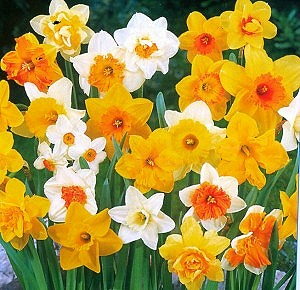
|
|
Narcissus
- cultvated varietes |
Narcissus
- Daffodil
Narcissus is the Latin name for a
large group of hardy, mostly spring-flowering, bulbs. There are several Narcissus species that bloom in the
autumn. Daffodil is the common English name for all narcissus. The botanic name of the genus is
Narcissus. They are mostly native to the Mediterranean region, but a few species are found through central Asia to
China. The range of forms in cultivation has been heavily modified and
extended, with new variations which increase every year.
There are over 25,000 varieties in shades of yellow, white, orange and peachy
pink.
No genus of flowering plants is more readily cultivated and less liable to
disease, and the presence in its leaves and roots of innumerable bundles of
needle-shaped crystals of calcium oxalate, termed raphides, protect it from injury of browsing and gnawing
animals, rendering the plants indigestible and possibly poisonous to cattle and smaller
animals.
The name is derived from that of the narcisstic youth of Greek mythology called
Narkissos and from the Greek word narkao (to benumb), on account
of the narcotic properties which the plant possesses.
This
famous, flower inspired myth is perhaps more suited to the beauty of the
narcissus. Narcissus
was an exceptionally handsome young man. His mother had told him that he
would live a long life if he did not look upon his own beauty.
Narcissus however,decided to see his reflection on the surface of
the water coming from a spring. He
was so enchanted by his own beauty that he remained there, still,
admiring his image until he died by the side of the spring. According
to another version, he mistakenly thought that his own reflection was
the face of the nymph that inhabited the spring and he drowned when we
jumped into the water trying to catch her. The narcissus flower
supposedly grew at that spot.
The popular English
name Daffodil, is a corruption of Asphodel, with which blossoms of the ancient Greeks this was supposed to be
identical.
There is an unproven sentiment that narcissus bulbs have healing
properties, though the toxic lectins make it an unwise choice to use
medicinally.
The 17th century herbalist, Nicholas Culpeper, recommended that crushed daffodil bulbs should be used to aid the healing of wounds - he also mentioned that the bulbs are known to have narcotic
properties. Nevertheless, it has been used for everything from cancer cure to headache remedy to poultice for
boils.
The Arabians commended the oil to be applied for curing baldness and as an
aphrodisiac. Daffodils are being grown for Galanthine, a substance in the bulbs being used to fight
Alzheimer's.
The little germination point within the bulb has long been regarded as an intoxicant & possible
hallucinogen, & narcissus essentially means "benumbed," as by a
drug, hence the association of the Narcissus with ancient mystery cults & altered states of mind bringing the mystic closer to the divine
realm.
Socrates called this plant the
'Chaplet of the infernal Gods,' because of its narcotic effects. An extract of the
bulbs, when applied to open wounds, has produced staggering, numbness of the whole nervous system and paralysis of the
heart.
In England
Poultry keepers thought the flower unlucky and would not allow it in the home as they believed it would stop their hens laying eggs or the eggs
hatching.
Source:
http://en.wikipedia.org/wiki/Narcissus
http://www.valentine.gr/mythology2_en.php
http://www.paghat.com/narcissusminnow.html
http://botanical.com/botanical/mgmh/n/narcis01.html
http://www.flowers.org.uk/Flowers/facts/k-r/narcissus.htm
